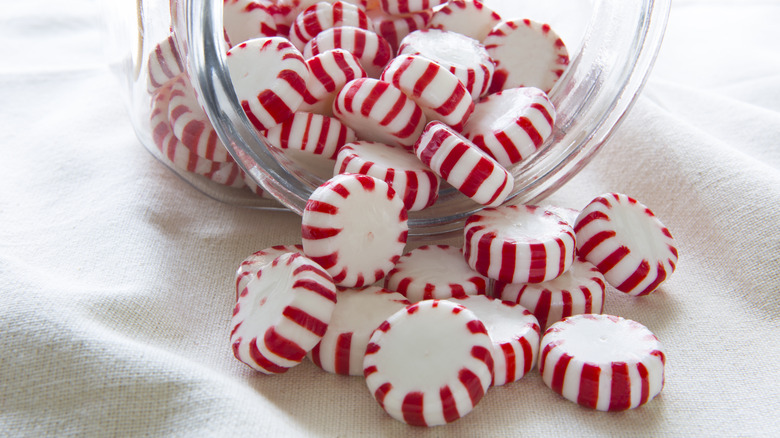The Potential Reason Mint Became A Classic Holiday Flavor
When the holiday season rolls around, flavors like gingerbread start popping up more and more on grocery store shelves. But, why do certain flavors become associated with certain holidays? And what's the deal with peppermint?
It's no mystery why fruitcake was invented and linked to Christmas. (Although, it might be a mystery why the dessert has stuck around for this long.) According to Mental Floss, the cake people love to hate was first invented by the Romans, who used fruitcake as a way to naturally preserve fruit (which presumably came in handy during the winter months, when fruit was harder to come by).
But, why did mint become a classic holiday flavor? Surprisingly enough, it isn't because of candy canes. In 1670, says History, a German choirmaster first passed out candy canes to the congregation's children to keep them quiet during mass. Since hard candy takes a while to suck down and the holiday service traditionally included a full reenactment of the Biblical nativity story, candy canes were a perfect solution.
But, those early candy canes started as simple sugar sticks; candy canes didn't get their peppermint flavor until they reached American shores and U.S. confectioners added the mint and red stripes. So, why did peppermint ice cream and peppermint bark become classic holiday treats? Like fruitcake, the reason is surprisingly utilitarian.
Mint is a digestif
The holidays have been a time of indulgence since the Middle Ages when folks raised their own food, per The Takeout. Incidentally, the livestock-slaughtering season coincided with the onset of cold-weather celebrations, which made winter a time of abundance. After enjoying a massive meal, those merry Medieval mirth-makers reached for nature's digestif: mint.
WebMD says the most widely known medicinal use of mint is as a digestif. Peppermint oil has been proven to help treat IBS and reduce abdominal discomfort with zero side effects. Per Healthline, studies have shown that food physically moves through the digestive system faster when folks enjoy a little peppermint after dinner — and just a little does the trick. ½ ounce of spearmint contains 1 gram of fiber, 9% of the recommended daily intake for iron, and 12% of the RDI for iron.
Mint continues to serve the same purpose in contemporary celebrations. Last year, a survey of 2,000 consumers via Fox News estimated just how much people planned to feast around the holidays. During the 2021 holiday season, 264 million slices of turkey, 250 million potatoes, and 208 million boxes of chocolate were washed down with 200 million cups of hot cocoa and 366 million glasses of wine. 'Tis the season for celebrating — and any good meal calls for an equally good punctuation mark. Enter mint: the Official Digestif of the Holiday Season.

